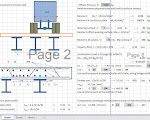Crack Width Calculation Spreadsheet

Crack Width.1.Crack Width Calculations.Order of Play Introduction What width is suitable for my project? Calculations to BS5400-4 Eurocode (Evan) Question Time.Crack Width Calculations 4 Design: general 4.1 Limit state requirements 4.1.1 Serviceability limit states 4.1.1.1 Cracking. Cracking of concrete should not adversely affect the appearance or durability of the structure. The Engineer should satisfy himself that any cracking will not be excessive, having regard to the requirements of the particular structure and the conditions of exposure. In the absence of special investigations, the following limits should be adopted. A) Reinforced concrete. Design crack widths, as calculated in accordance with 5.8.8.2, should not exceed the values given in Table 1 under the loading given in 4.2.2.

BS5400-4-1990 Introduction.What width is suitable for my project? (Table 1 BS5400-4) viewed on 23/09/09 0.25 mm Environment: Severe – Concrete surfaces exposed to driving rain OR alternate wetting and drying. 0.25 mm Environment: Moderate – Concrete surfaces above the ground level and protected from the following: rain de-icing salts sea water spray 0.25 mm Environment: Moderate – Concrete surfacing permanently saturated in water with a pH 4.5.What width is suitable for my project? (Table 1 BS5400-4) viewed on 23/09/09 0.15 mm Environment: Very Severe – Concrete surfaces directly affected by de-icing salts or sea water spray. 0.10 mm Environment: Extreme – Concrete surfaces exposed to abrasive action by sea water or water with a pH.
Crack Width Calculation Spreadsheet 2016

Crack Width Calculation For Water Tank
Good day all,I am currently using RSA to calculate the expected crack widths to BS 8110 for a certain shell structure.How does RSA take into consideration the long term effects such as creep when calculating crack widths? I would expect a reduction in the short term E modulus based on a creep coefficient:E(long) = E(short) / ( 1 + creep coefficient).However, when I manually adjust the creep coefficient in SLS parameters for plate/shell reinforcement code parameters I get no change in the required steel. I would expect a decrease in the required steel for a decrease in creep coefficient bearing in mind that SLS steel requirements are much larger than ULS.Kind regards,Dane. Hi Artur,I have attached a small test model.I have limited the crack width to 0.15mm with reinforcement correction and have set the design code to BS 8110.I have tried the following to change the reinforcement:1. Manually change creep coefficient. This only changes deflection results which is to be expected but does not effect the crack width rebar.2. Change the material E modulus in case RSA halves the E(short) as recommended by BS8110-2.
This again does not change the reinforcement.Regards,Dane.